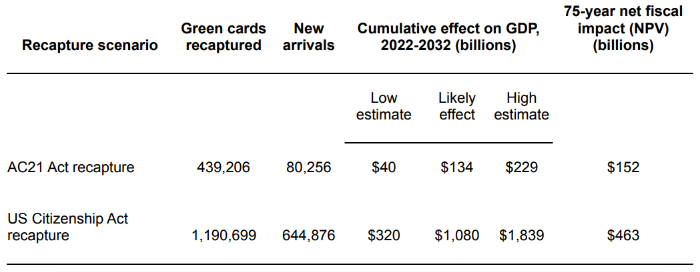Congress has the opportunity to recapture more than a million unused green cards through the reconciliation process, which would likely contribute approximately $1.080 trillion to US GDP over ten years and increase net revenue to federal, state, and local governments by approximately $463 billion.
Green card waste is a long-standing issue. Since 1992, hundreds of thousands of green cards authorized by Congress have been left unissued due to administrative complications. COVID-19 has exacerbated the problem significantly, with more green cards likely to go unused this year than in any previous year.
In the State Department’s recent public Q&A with Charlie Oppenheim, Chief of the Immigrant Visa Control and Reporting Division of the U.S. Department of State, Oppenheim shared his estimates of the number of visas likely to go unused in FY 2021: 150,000 family preference visas and 100,000 employment-based visas.
In our recent report “Stop the Incinerator: The high cost of green card slots going unused and the benefits of recapturing them,” my coauthors at the Federation of American Scientists and I estimated the economic and fiscal impact of recapturing green cards that went unused between 1992 and 2020. But because so many green cards are poised to be wasted this year, our estimates substantially underestimated the total possible benefit of recapture.
Using Oppenheim’s estimates of FY2021’s green card waste with the methodology described in our report, we can estimate the magnitude of the economic and fiscal effects if Congress recaptured green cards that went unused through 2021. The economic and fiscal effects are outlined in the table below. Details on the methodology can be found on pages 14-25 of the report here.
The economic and fiscal effects of two recapturing scenarios, extended through FY2021

Amending the American Competitiveness in the 21st Century (AC21) Act only recaptures unused employment-based green cards. Hence, under AC21 recapture, merely including FY2021 would increase the number of green cards available for recapture by about 100,000, lead to an additional 18,000 new arrivals, add $30 billion more to GDP over ten years, and raise another $34 billion in net revenue, relative to only recapturing unused green cards from 1992-2020.
The economic and fiscal impact of including FY2021 in AC21 recapture
By contrast, the recapture provisions from the U.S. Citizenship Act include both unused employment-based and family preference green cards. Modifying those provisions to recapture unused green cards through FY2021 would recapture an additional 250,000 green cards, lead to about 158,000 additional new arrivals, contribute an additional $265 billion to GDP over ten years, and raise an additional $100 billion in net revenue.
The economic and fiscal impact of including FY2021 in USCA recapture
Reconciliation affords Congress a unique opportunity to address large shortfalls in legal immigration, reduce the fiscal burden, and generate more than a trillion dollars in economic activity over the next decade.
Photo by Krisztian Kormos from Pexels